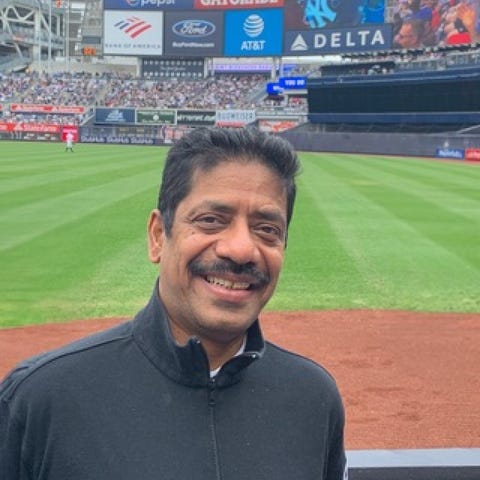The man who gave blockchains context and taught computation to care:
Anantha Krishnan is not your typical CEO. He’s not in it for the hype, the VC flexes, or the yacht parties in international waters. He’s in it to rewire the internet with context, with purpose, and maybe with a little bit of elbow grease. He’s going to rebuild the digital world from the inside out. Not just to make it faster or flashier, but to make it human again.
People call him the Digital Mechanic. Not because he wears overalls or carries a wrench, but because when the internet started rattling and leaking trust, Anantha rolled up his sleeves and started fixing the system where it counts, at the foundation.
Meet Anantha Krishnan:
Anantha Krishnan is a builder, strategist, and systems thinker with over 25 years of experience working at the intersection of enterprise technology, distributed systems, and human-centered design.
He began his career as a software engineer at Oracle, where he worked on large-scale database systems and enterprise infrastructure. At Accenture, he helped design and implement digital transformation strategies for Fortune 500 companies, specializing in scalable architecture, secure systems integration, and early innovation in analytics, big data, and AI before AI even became a buzzword. His work focused heavily on big data management and data safety, ensuring that systems could scale without compromising security or trust.
He holds a Computer Science degree from the prestigious Indian Institute of Technology (IIT) Bombay and an MBA from NYU Stern School of Business, combining technical depth with strategic and economic fluency.

Over the course of his career, Anantha has published widely on distributed systems, holds patents in peer-to-peer architecture and context-aware networks, and has consistently been at the forefront of architecting large, mission-critical digital systems that prioritize both performance and purpose.
But that’s just the resume.
What sets him apart is his ability to see through systems and imagine what they should be, not just what they are. Instead of accepting the limitations of the current internet (fragmented, extractive, and impersonal), he asked a simple but radical question: What if we designed computation around people?
That question led to something entirely new.
The Big Idea: Contextual Compute
For decades, computation has been excellent at one thing, processing information. It slices, it dices, it stores terabytes in nanoseconds. But there’s one thing it has never been good at: understanding people.
The internet doesn’t struggle with facts. It struggles with context. It doesn’t know who is clicking, why they’re clicking, or whether that click is a joke, a cry for help, or just someone half-asleep tapping their phone in bed.
Traditional systems treat everyone the same. They flatten us into “users” and turn every interaction into a line of input with no memory, no nuance, and no room for intent. You get served the same experience whether you’re an eleven-year-old looking for cat videos or a cryptographer debugging smart contracts at 2 a.m.
Anantha looked at that and thought, what if machines could adapt, not just to data, but to people?
That idea became Contextual Compute.
At its core, Contextual Compute is a new model where people aren’t passengers in a digital machine. They’re the drivers. The system is designed to understand not just what you’re doing, but who you are, what you value, and what you’re trying to accomplish.
It’s about more than performance. It is about relevance.
It’s about more than personalization. It is about understanding intent.
It’s about more than speed. It is about meaningful interaction.
In the same way a great conversation adjusts to tone, timing, and intention, Contextual Compute builds systems that actually respond to their participants like real-world interactions do. Not everything needs to be optimized for clicks per second. Some things should be optimized for trust, agency, and joy.
This is not just smarter computation. It is a friendlier, more cooperative, more human foundation for the digital world.
And Then He Built It
Contextual Compute is not just a theory. It powers MOI Protocol, the first context-aware blockchain. Under the hood is the Interaction State Machine, a system that makes MOI feel more like a conversation than a transaction.
MOI already runs on a live network of more than two thousand nodes, with a mainnet planned for the near future. There are no bridges, no bottlenecks, and no shortcuts. Just participant-centric infrastructure designed for the real world.
Bitcoin gave us trustless money. Ethereum gave us programmable contracts. MOI is aiming at something bigger: real world assets and real world coordination. That’s why participant-centric computing isn’t just a design choice. It’s a requirement. Contextual Compute makes it possible to represent people, intent, and interaction with the nuance the real world demands.
To support this vision, Anantha founded Sarva Labs, a deep tech R&D company. He also launched the Contextual Compute Foundation, a nonprofit dedicated to open research, governance, and education around this new model of computation.
Anantha bootstrapped the idea with support from friends and family, contributing over six million dollars of his own money into the development of the ecosystem. There were no private token deals, and no institutional whales. Just belief, commitment, and code.
Why It Matters
Today’s blockchain and AI systems often prioritize speed and scale over meaning and adaptability. But these systems are shaping real human interactions. They should be designed to reflect that responsibility.
MOI is different. It finalizes transactions locally, preserving decentralization without fragmentation. It supports context-aware AI models that can adapt to each user while preserving privacy and alignment. It keeps people in control of their digital lives by design.
This is not just an engineering challenge. It is a societal one. Anantha is building digital infrastructure that serves people, not the other way around.
The Digital Mechanic
Anantha Krishnan does not see himself as a visionary standing on a stage. He sees himself as a mechanic in the engine room, making sure every piece of the system actually works. He is hands-on, precise, and relentlessly focused on building something that lasts.
He is also known for keeping a folder of memes labeled “In Case of Emergency,” which somehow always seems to apply.
While other founders chase trends, Anantha is laying the foundation for a digital society based on participation, not extraction.

The Future Runs on Context
Anantha Krishnan is not just a CEO. He is the architect of a future internet that listens, adapts, and respects its users.
He has written the models, built the infrastructure, shipped the testnets, and funded the movement himself.
Now, he is inviting others to join. Not to speculate on tokens, but to co-create a new kind of digital society, one where context is not an afterthought but the starting point.
If the internet had a soul, MOI would be it.
Anantha Krishnan isn’t following the future. He’s engineering it.

